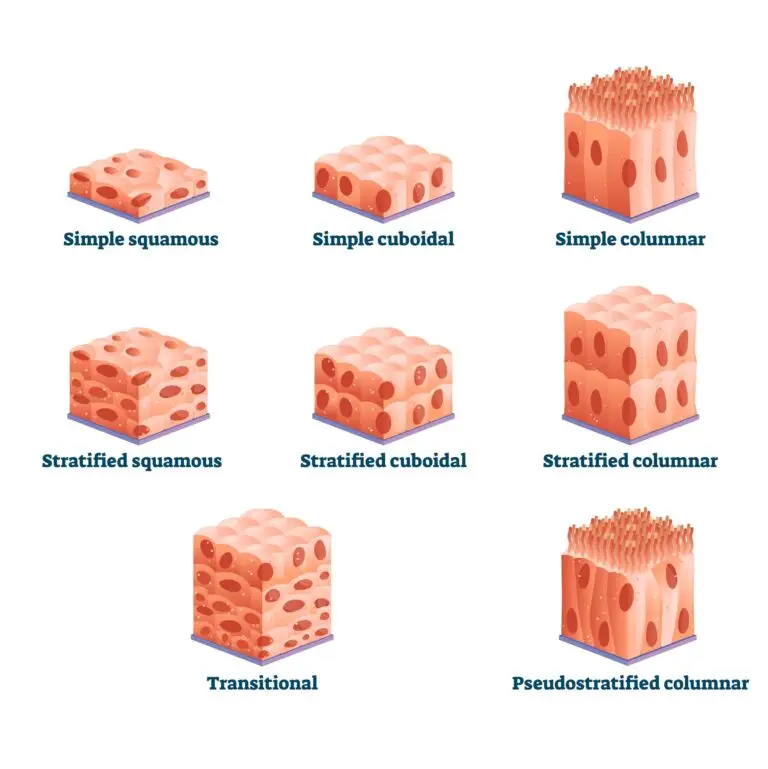Epithelial Tissue

Table of Contents
What is Epithelial tissue?
Epithelial tissue is one of the four basic types of animal tissues, along with connective tissue, muscle tissue, and nervous tissue. It covers the surfaces of the body, both external and internal, and serves as a protective barrier.
Epithelial tissue is characterized by tightly packed cells with little extracellular matrix, forming continuous sheets that line various structures and cavities.
Characteristics of Epithelial Tissue
Cellularity
Epithelial tissue is characterized by its high cellularity, consisting of closely packed cells with minimal to no intercellular matrix between them. This dense arrangement of cells forms a continuous layer that covers body surfaces, lines cavities, and forms glands.
The proximity of epithelial cells allows them to function effectively as barriers against the entry of pathogens and in the absorption, secretion, and sensation processes. The lack of intercellular matrix in epithelial tissues facilitates tight junctions between cells, ensuring cohesive and protective layers essential for the body’s defense and functional integrity.
Polarity
Epithelial cells exhibit polarity, meaning they have distinct apical (upper) and basal (lower) surfaces. The apical surface faces a lumen, external environment, or a free surface, while the basal surface is attached to the underlying connective tissue.
Avascularity
Epithelial tissue is avascular, meaning it does not contain blood vessels. Instead, it relies on the diffusion of nutrients and oxygen from the underlying connective tissue, which is vascular, and supplies these essential substances.
The absence of blood vessels in epithelial tissues means they must obtain oxygen and nutrients through diffusion across the basement membrane. This thin layer separates the epithelial cells from the connective tissue.
This arrangement allows epithelial tissues to form effective barriers on body surfaces and internal cavities without disrupting blood vessels passing through them, maintaining the integrity and function of these protective layers.
Regeneration
Epithelial cells possess a high regenerative capacity, which enables the rapid replacement of damaged or lost cells. This characteristic is crucial for maintaining the integrity and function of epithelial tissues, which frequently encounter environmental stressors, such as abrasion, pathogens, and chemical irritants.
The ability to quickly regenerate is facilitated by the presence of stem cells in the epithelium or by the mitotic activity of existing epithelial cells. These cells can proliferate and differentiate to replace those that have been lost, ensuring the continuous protection and effective functioning of the tissue.
This regenerative property is especially important for epithelial tissues that line surfaces such as the skin, gastrointestinal tract, and respiratory system, where cell turnover is high due to constant exposure to external factors.
Classification Based on Shape
Epithelial cells can be classified based on their shape:
- Squamous: Flat and scale-like.
- Cuboidal: Cube-shaped.
- Columnar: Tall and column-shaped.
Classification Based on Layers
Epithelial tissue can be classified based on the number of cell layers:
- Simple epithelium: Single layer of cells.
- Stratified epithelium: Multiple layers of cells.
Types of Epithelial Tissue
- Simple Squamous Epithelium:
- Single layer of flat, scale-like cells. Found in areas where rapid diffusion and filtration occur, such as the lining of blood vessels (endothelium) and air sacs in the lungs (alveoli).
- Simple Cuboidal Epithelium:
- Single layer of cube-shaped cells. Found in kidney tubules, ducts of glands, and the surface of ovaries.
- Simple Columnar Epithelium:
- Single layer of tall, column-shaped cells. Found in the lining of the digestive tract, where absorption and secretion take place.
- Stratified Squamous Epithelium:
- Multiple layers of flat cells. Found in the skin (epidermis) and lining of the oral cavity, esophagus, and vagina.
- Stratified Cuboidal Epithelium:
- Multiple layers of cube-shaped cells. Rare in the body and found in some ducts of sweat glands and mammary glands.
- Stratified Columnar Epithelium:
- Multiple layers of tall, column-shaped cells. Found in the pharynx and male urethra.
- Pseudostratified Columnar Epithelium:
- Appears stratified but all cells are attached to the basement membrane. Found in the respiratory tract, where it contains goblet cells producing mucus.
- Transitional Epithelium:
- Specialized for stretching and found in the lining of the urinary bladder and parts of the ureters and urethra.
Related Links
Anatomy
Tissue
Plasma Membrane
Vascular Bundle